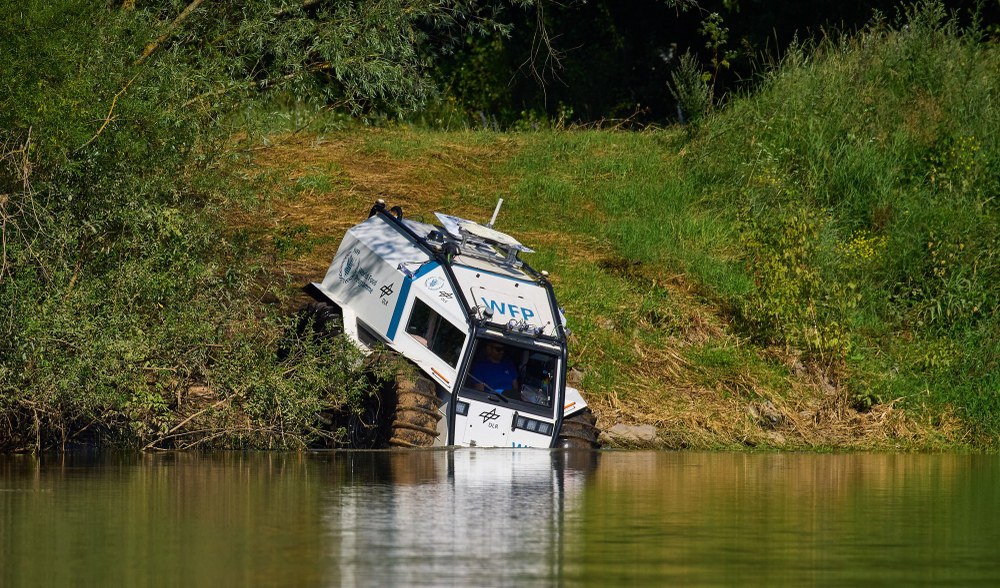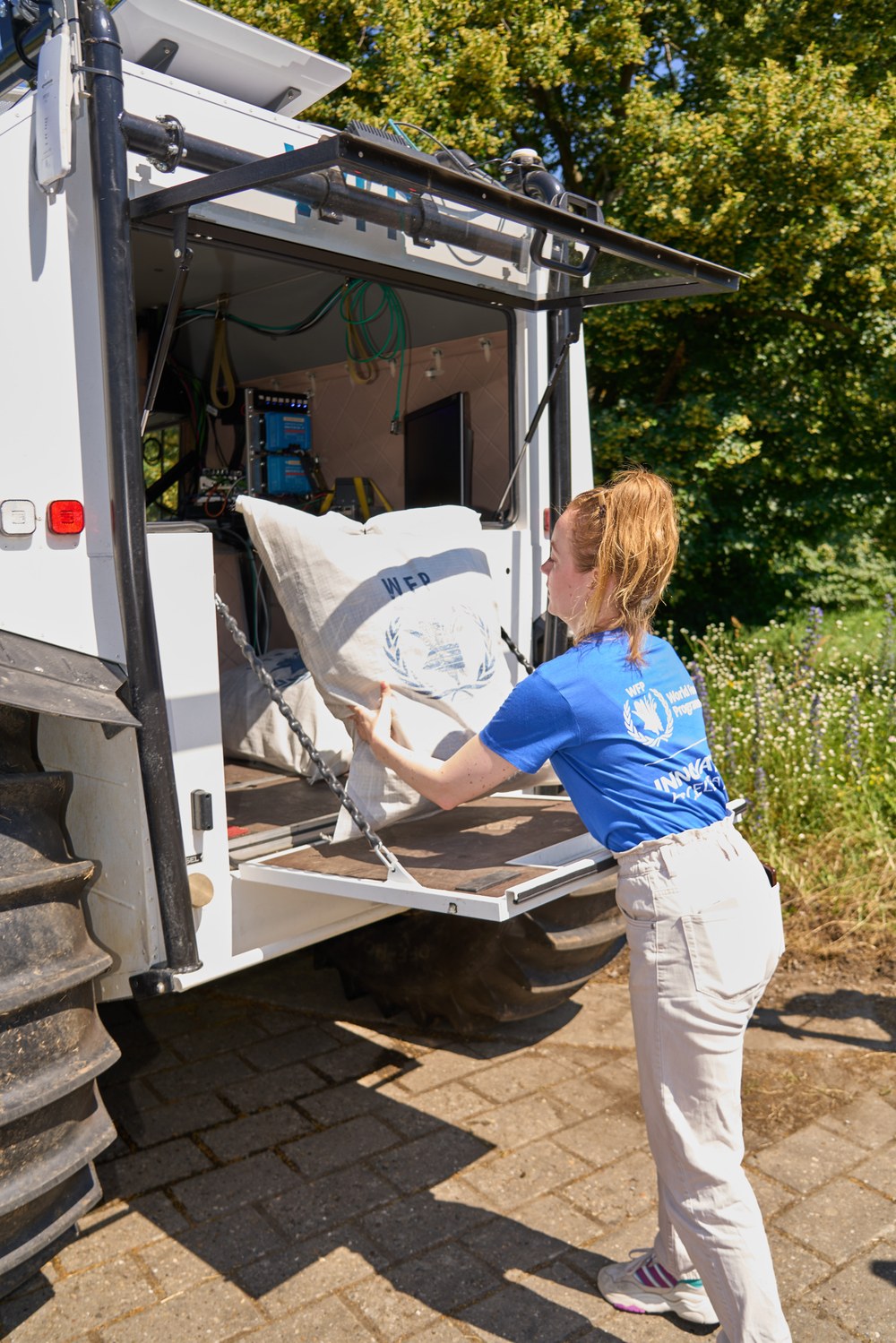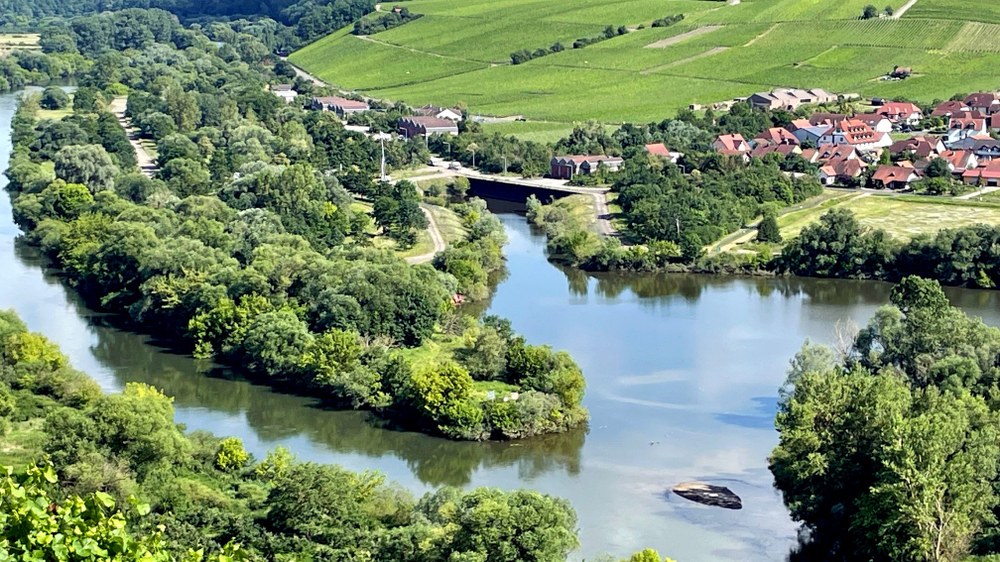AHEAD – Technologies for humanitarian aid and crisis response



- On 25 June 2024, a SHERP all-terrain vehicle was semi-autonomously remote-controlled through rough terrain and a lake at the AHEAD (Autonomous Humanitarian Emergency Aid Devices) project demonstration.
- DLR is working with partners to develop technologies for humanitarian aid and disaster relief in the AHEAD project. Researchers tested two deployment scenarios in Nordheim am Main, Bavaria, Germany, with both the United Nations World Food Programme and the Bavarian Red Cross.
- Focus: Humanitarian aid, disaster relief, Earth observation, spaceflight
In a live demonstration on 25 June 2024, the AHEAD (Autonomous Humanitarian Emergency Aid Devices) project presented advanced technologies for humanitarian aid and disaster management. The German Aerospace Center (Deutsches Zentrum für Luft- und Raumfahrt; DLR) is working with partners to develop technologies and capabilities for remote-controlled transportation to support disaster relief. The aim is for driverless vehicles to reach areas that are inaccessible for boats or road vehicles or too dangerous for emergency services personnel.
Users and decision-makers on board
In close cooperation with the United Nations World Food Programme (WFP) and the Bavarian Red Cross (BRK), the AHEAD team simulated two realistic scenarios at the demonstration: a food delivery, based on current operations in South Sudan, and a relief and rescue operation in a flood situation similar to that in the Ahr Valley in 2021 and most recently in southern Germany. Various special units of the BRK were involved in the flood scenario with over 20 emergency workers.
The Bundeswehr training area in Nordheim am Main, Bavaria, offered the project team ideal conditions, including extensive, rough and densely overgrown areas, together with a lake with steep banks. This was the first time that the all-terrain, semi-autonomous SHERP vehicle demonstrated its amphibious abilities. SHERPs are particularly suitable for off-road use and are already being used by the WFP for aid deliveries, albeit still with drivers at the wheel. As the drivers are exposed to great dangers, such as disease-carrying insects, epidemics or landmines, in the future, SHERP trucks are to be controlled remotely using telerobotics.
"Validating our technologies through the AHEAD demo is a very complex operation, as various teams and technical components have to work together. We are very pleased and proud to have successfully teleoperated the SHERP vehicle after four years of research, through rough terrain and for the first time in water. The strong team spirit was an especially rewarding experience for me – everyone is working together to put the knowledge gained into practice and drive the research forward," summarises overall project manager Armin Wedler from the DLR Institute of Robotics and Mechatronics.
The demonstration took place as part of a three-day workshop. In addition to researchers, end users and decision-makers, Tobias Gotthardt, State Secretary in the Bavarian Ministry of Economic Affairs, Regional Development and Energy, took part as a special guest and was able to see the potential applications of AHEAD technologies for himself: "The achievements of the project partners here, under the overall management of DLR, are particularly impressive. It shows once again how diverse the potential applications of AI, autonomous driving and space technologies are. I am extremely pleased that we are able to make a contribution to disaster prevention and humanitarian aid through the Bavarian funding of two partner projects. It is indeed the pinnacle of dual use when space technology helps to make our world a better place."
Globally deployable and responsive
To enable the special SHERP vehicle to fulfil its tasks, several operating units need to work together. A global mission control centre (GMOC) plans and monitors the remote truck mission, implemented by the Center for Satellite Based Crisis Information (ZKI) at the DLR Earth Observation Center. The control hub collects and evaluates remote sensing data, such as high-resolution satellite images, aerial photographs and drone imagery, to determine the environment and optimum route. The units on site receive the results in the form of situation reports and an interactive web application. In future operations, the GMOC will be a fixed centre that can support operations globally, but for the demonstration in Nordheim, the team set up the control centre in a demarcated location on the test site that had no view of the incident simulation.
Set up in a mobile container at the deployment site, the local mission control centre (LMOC) is connected to the GMOC and teleoperates the truck. The SHERP is directed along a pre-planned route, with the remote driver in the LMOC taking live data into account as it progresses. The vehicle continuously transmits its position and 360-degree data on its surroundings from onboard sensors and stereo cameras. This enables the driver to safely avoid hazards such as narrow passages and unexpected obstacles.
Sensory remote control at all times
To control the vehicle remotely, the driver sits at an input station with functions such as lights, horn, gear shift and foot pedals. They can guide the SHERP intuitively and physically feel how the vehicle behaves off-road thanks to 'force feedback'. This sensory driving aid derives from telerobotic technologies that originated in space research and are being further developed in AHEAD for humanitarian aid and crisis operations on Earth.
For ongoing data exchange, the two control centres and the vehicle are connected to each other via several communication systems, including mobile phone networks, satellite communication and broadband internet. The LMOC is also connected to the vehicle via direct radio contact. The DLR Institute of Communications and Navigation is contributing its expertise here, with researchers calculating the communication coverage for route planning in advance to ensure connectivity throughout the mission. In addition, robust and secure communication between the LMOC and the vehicle was ensured and validated.
Cooperation with users and industry
With the successful live demonstration, AHEAD has taken another important step towards making its technologies ready for use. The two DLR spin-offs Sensodrive and Roboception have demonstrated how technology transfer from research can succeed, and these enterprises are among the industrial partners of the project that have established themselves on the market with their solutions in the fields of telerobotics and perception. Collaboration with future users such as the Bavarian Red Cross and World Food Programme is indispensable for targeted development.
"Today's successful live demonstration of the AHEAD project convincingly shows how we can use innovative technologies to make humanitarian missions in hard-to-reach areas even more efficient. The project is an outstanding example of innovation and an important milestone on our path to a world without hunger," explains Bernhard Kowatsch, Head of the WFP Innovation Accelerator.
In their test scenarios, the AHEAD team showed that ad hoc operations in the event of natural disasters and acute crises are just as feasible as pre-planned aid missions in everyday humanitarian operations. The project team will analyse the data collected during the live demonstration to expand capabilities and make technologies even more efficient.
Related links
- The United Nations World Food Programme (WFP)
- DLR Institute of Robotics and Mechatronics
- Bavarian Ministry of Economic Affairs, Regional Development and Energy
- Center for Satellite based Crisis Information (ZKI)
- Earth Observation Center (EOC)
- DLR Institute of Communications and Navigation
- DLR Institute of Transportation Systems
- Sensodrive GmbH
- Roboception GmbH
- Blickfeld GmbH
- VDI/VDE Innovation + Technik GmbH
About the project
AHEAD (Autonomous Humanitarian Emergency Aid Devices) is a project of the German Aerospace Center (DLR). The following institutions and companies are involved: DLR Institute of Robotics and Mechatronics (project management), DLR Institute of Communications and Navigation, Center for Satellite Based Crisis Information (ZKI) at the DLR Earth Observation Center, DLR Institute of Transportation Systems, WFP Innovation Accelerator of the United Nations World Food Programme, Roboception GmbH, Sensodrive GmbH, Blickfeld GmbH and the project management agency VDI/VDE Innovation + Technik GmbH (VDI/VDE-IT). The AHEAD project also includes the partner projects KI4HE, MaiSHU, MUSERO, iFOODis and RESITEK, with funding from the Bavarian Ministry of Economic Affairs, Regional Development and Energy.
